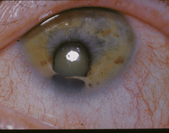|
Merle is a pattern in a dog's coat. Merle comes in different colors and patterns. The merle gene creates mottled patches of color in a solid or piebald coat, blue or odd-colored eyes, and can affect skin pigment as well. Health issues are more typical and more severe when two merles are bred together, so it is recommended that a merle be bred to a dog with a solid coat color only. Ocular defects: Dogs who are homozygous for the merle pattern gene often have visual and auditory deficits. These dogs are sometimes referred to as 'double merle' and sometimes incorrectly referred to as 'lethal white.' Ocular defects include microphthalmia, conditions causing increased ocular pressure, and colobomas, among others. Double merle dogs may be deaf or blind or both, and can carry ocular defects in blue or colored eyes. Currently no studies have been done to prove whether or not the merle gene affects the eyes, causing blindness. Auditory defects: In one study of 38 dachshunds by a German researcher, partial hearing loss was found in 54.6% of double merles and 36.8% of single merles. 1 out of the 11 (9.1%) double merles was fully deaf while none of the single merles were. Another study done by Texas A&M University found that of 22 double merles, 8 were completely deaf and two were deaf in one ear. Of 48 single merles, only one was deaf in one ear, and none were completely deaf. In another study of 70 dogs, 15 of them Catahoula Curs, 4 of the Catahoulas were deaf, while 86% of the double merles of other breeds were deaf.Deaf, blind, and deaf and blind dogs can have good lives when properly cared for. There are a variety of internet groups dedicated to supporting carers of such dogs. Deaf dogs can compete successfully in agility and there are many anecdotal reports of deaf/blind dogs earning their Canine Good Citizen certification, working as therapy dogs, and competing in dog sports like tracking or Nosework. Credits to: en.wikipedia.org
1 Comment
|
Archives
June 2020
Categories |
Proudly powered by Weebly

 RSS Feed
RSS Feed